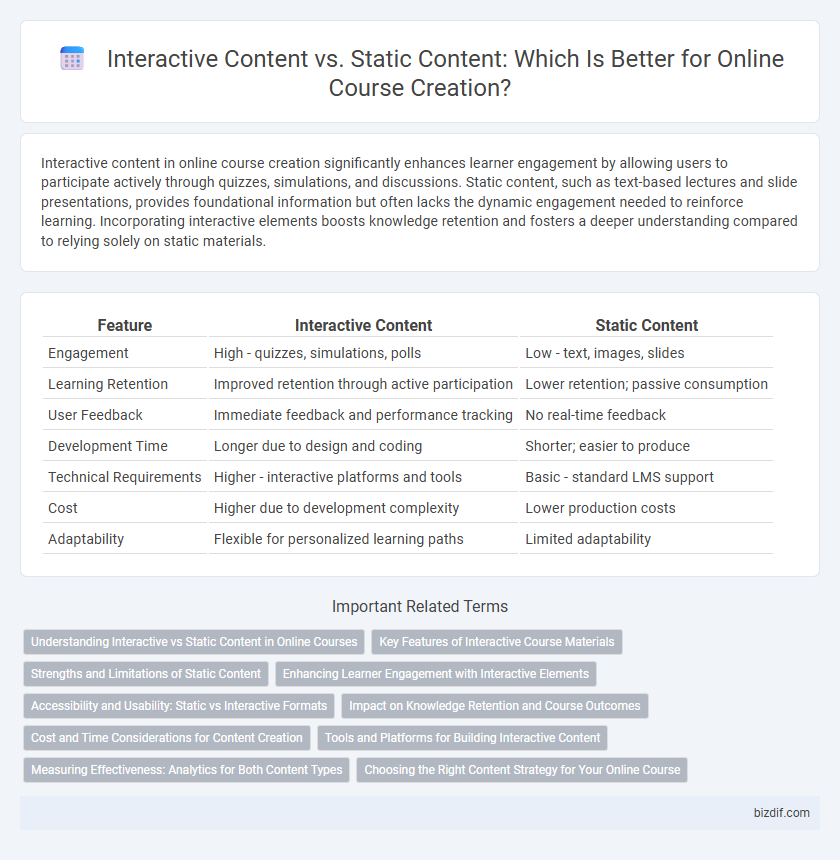Interactive content in online course creation significantly enhances learner engagement by allowing users to participate actively through quizzes, simulations, and discussions. Static content, such as text-based lectures and slide presentations, provides foundational information but often lacks the dynamic engagement needed to reinforce learning. Incorporating interactive elements boosts knowledge retention and fosters a deeper understanding compared to relying solely on static materials.
Table of Comparison
| Feature | Interactive Content | Static Content |
|---|---|---|
| Engagement | High - quizzes, simulations, polls | Low - text, images, slides |
| Learning Retention | Improved retention through active participation | Lower retention; passive consumption |
| User Feedback | Immediate feedback and performance tracking | No real-time feedback |
| Development Time | Longer due to design and coding | Shorter; easier to produce |
| Technical Requirements | Higher - interactive platforms and tools | Basic - standard LMS support |
| Cost | Higher due to development complexity | Lower production costs |
| Adaptability | Flexible for personalized learning paths | Limited adaptability |
Understanding Interactive vs Static Content in Online Courses
Interactive content in online courses engages learners through quizzes, simulations, and drag-and-drop activities, enhancing retention and comprehension. Static content, such as PDFs, slides, and text-based lessons, offers foundational knowledge but lacks real-time feedback and user involvement. Understanding this distinction helps educators design courses that balance interactivity for active learning with static materials for focused information delivery.
Key Features of Interactive Course Materials
Interactive course materials engage learners through quizzes, simulations, and multimedia elements that promote active participation and immediate feedback. Key features include adaptability to individual learning paces, real-time progress tracking, and enhanced retention through immersive experiences. These elements contrast with static content, which typically offers passive consumption without dynamic interaction or personalized engagement.
Strengths and Limitations of Static Content
Static content in online course creation offers consistent, easily accessible material that ensures learners can review information anytime without bandwidth concerns. Its strengths lie in simplicity and reliability, allowing quick updates and clear presentation of foundational knowledge. However, static content lacks engagement and adaptability, limiting interactivity and real-time feedback crucial for deeper comprehension and learner motivation.
Enhancing Learner Engagement with Interactive Elements
Interactive content significantly boosts learner engagement compared to static content by promoting active participation through quizzes, simulations, and gamified elements. These dynamic features encourage deeper cognitive processing and immediate feedback, leading to improved knowledge retention and motivation. Implementing interactive elements in online courses transforms passive viewers into engaged learners, fostering a more effective and personalized educational experience.
Accessibility and Usability: Static vs Interactive Formats
Interactive content enhances accessibility by allowing users to engage through multiple input methods such as clicks, swipes, and voice commands, accommodating diverse learning needs and preferences. Static content, often limited to text and images, may pose challenges for users with disabilities due to its lack of adaptive features and limited user control. Prioritizing interactive formats in online course creation improves usability by fostering active participation, immediate feedback, and personalization, which static formats generally cannot provide.
Impact on Knowledge Retention and Course Outcomes
Interactive content in online course creation significantly enhances knowledge retention and improves course outcomes by actively engaging learners through quizzes, simulations, and real-time feedback. Static content, such as text and images, often leads to passive learning and lower retention rates, reducing overall effectiveness. Studies show courses incorporating interactive elements increase learner motivation and comprehension, resulting in higher completion rates and better performance on assessments.
Cost and Time Considerations for Content Creation
Interactive content often requires higher investment in specialized tools, software, and multimedia resources, increasing both cost and production time compared to static content. Static content, such as PDFs or slide decks, is typically faster and less expensive to produce, making it ideal for budget-conscious online course creators. Evaluating the trade-off between the initial cost and the potential for increased learner engagement is crucial in the content development process.
Tools and Platforms for Building Interactive Content
Tools like Articulate Storyline, Adobe Captivate, and H5P enable creators to build engaging interactive content including quizzes, simulations, and drag-and-drop activities, enhancing learner engagement and retention. Platforms such as Teachable and Thinkific support embedding these interactive elements seamlessly within their user-friendly course frameworks, allowing for a dynamic learning experience. Static content creators often rely on basic LMS capabilities, but interactive content emphasizes platforms that offer advanced features and customization options to foster active learning.
Measuring Effectiveness: Analytics for Both Content Types
Measuring effectiveness in online course creation involves using analytics tools to track learner engagement and performance across both interactive and static content types. Interactive content often yields higher engagement metrics such as click rates, completion rates, and time-on-task data, providing detailed insights into learner behavior and preferences. Static content analytics typically focus on view counts and dropout rates, offering a baseline measurement to compare against interactive content's deeper engagement analytics.
Choosing the Right Content Strategy for Your Online Course
Interactive content such as quizzes, simulations, and polls significantly enhance learner engagement and retention compared to static content like text and images. Selecting the right content strategy involves analyzing your target audience's preferences and learning objectives to determine the optimal balance between interactive and static elements. Incorporating interactive content where appropriate can boost course completion rates and improve overall learner satisfaction.
Interactive content vs Static content Infographic

 bizdif.com
bizdif.com